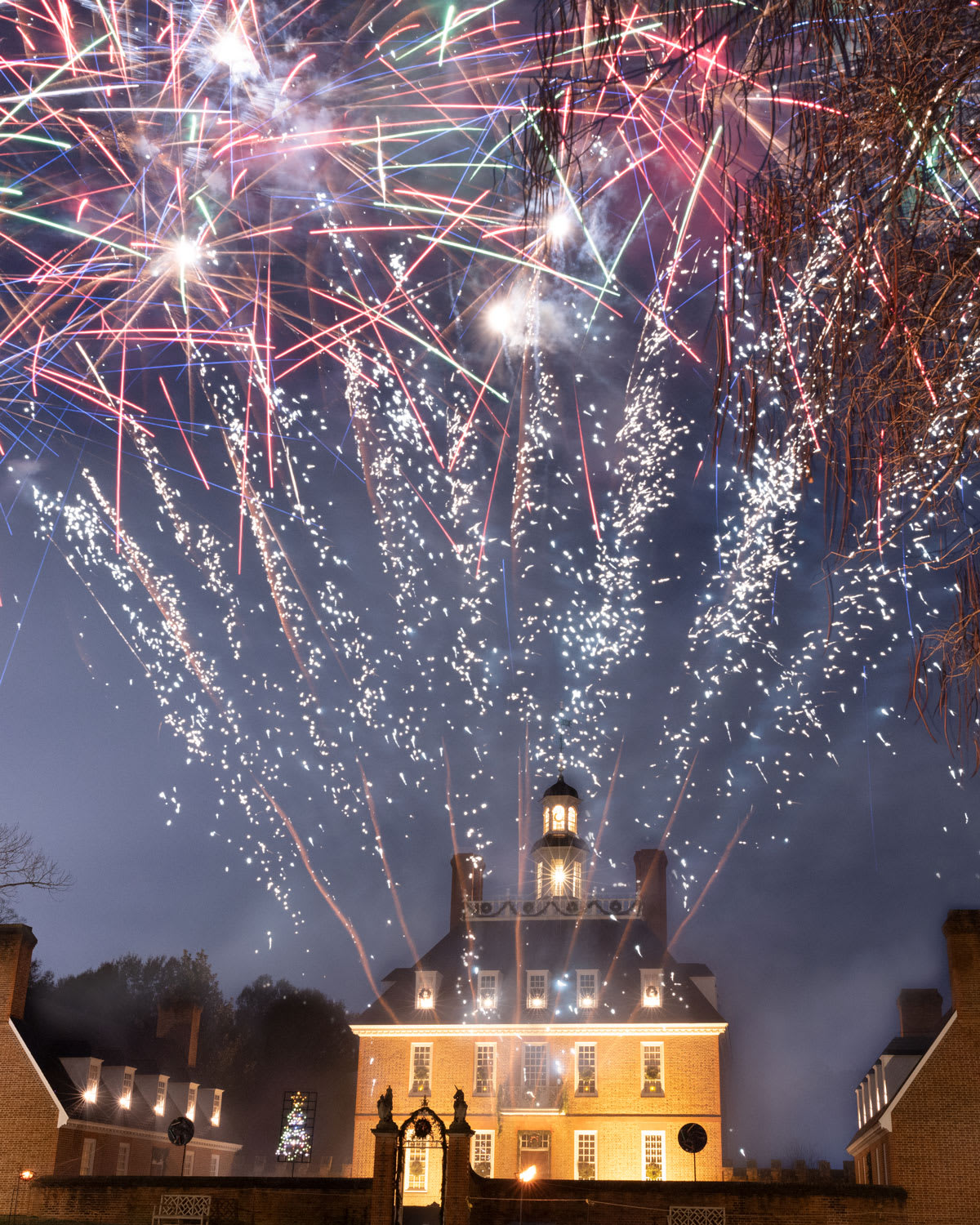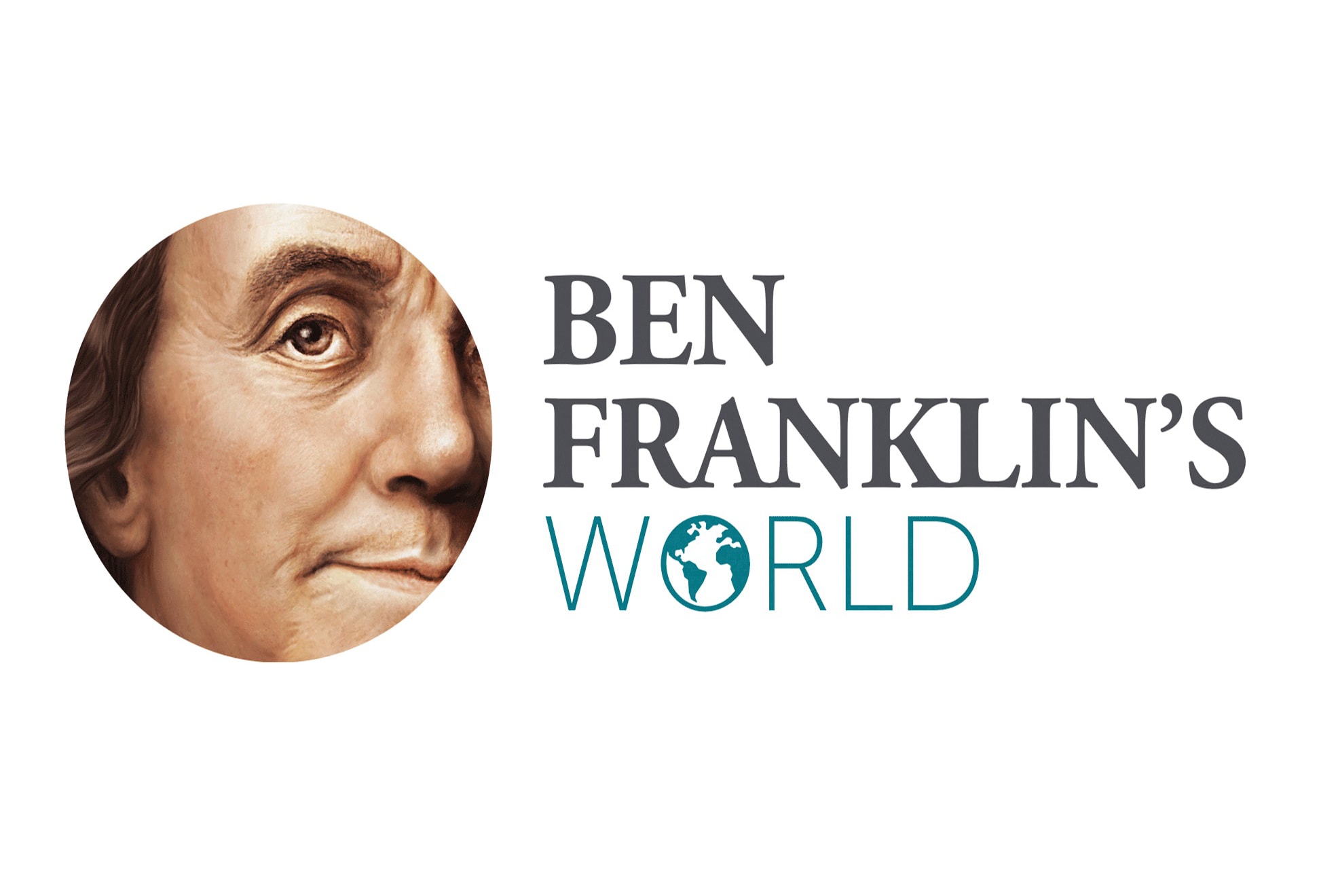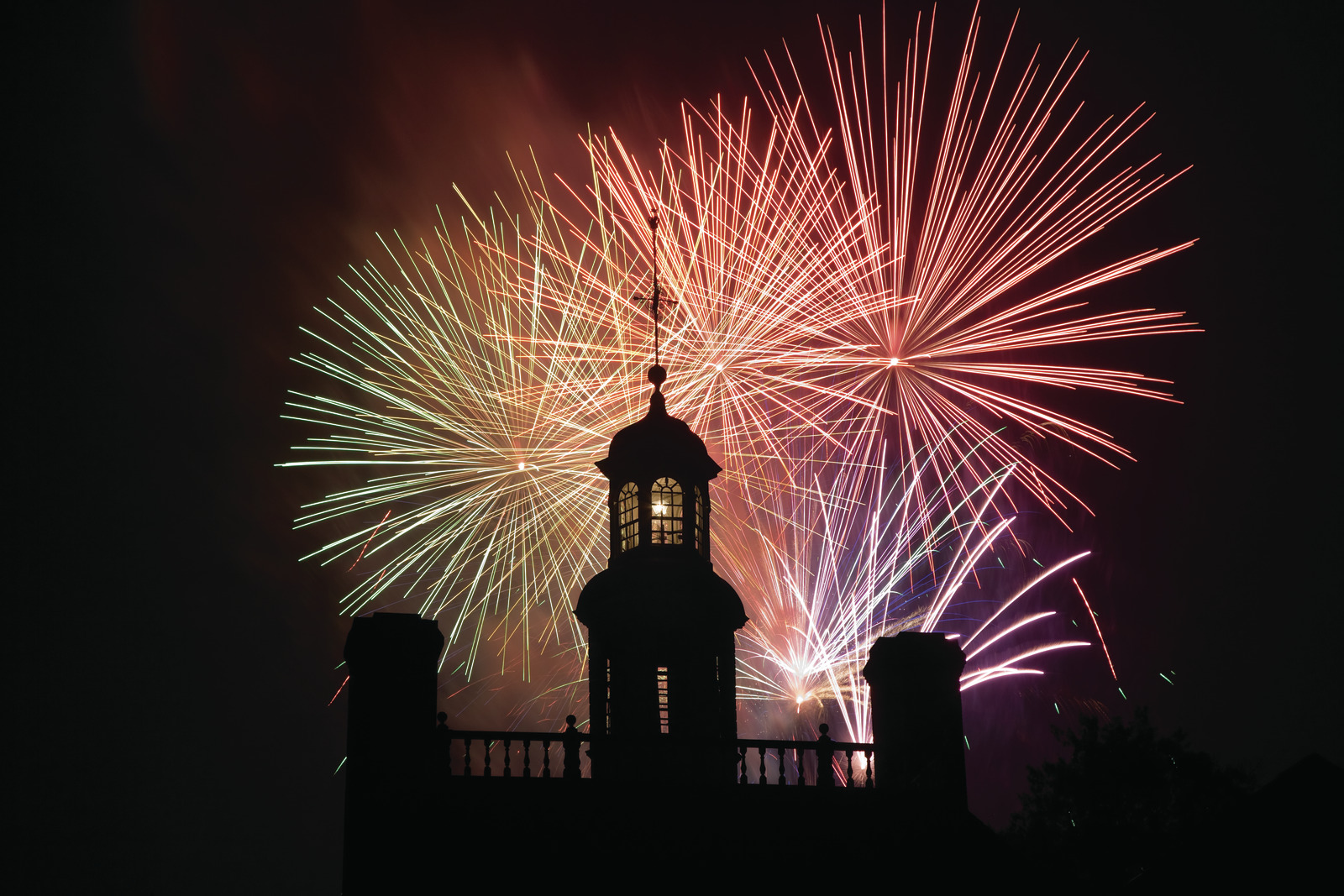During the American Revolution, nighttime light shows marked the climax of many public celebrations. People feasted, toasted, and listened to speeches during the day. Artillery roared and church bells clanged. Then at night, the town would illuminate.
Some celebrants placed lamps or candles in their windows. Wealthy homes placed thin cloth or paper in front of the light to create illuminated scenes. Crowds would admire the illuminations from the street while awaiting the evening’s finale, a fireworks show.1
Fireworks shows could be elaborate events. Some featured a central structure with painted illuminations, which might convey political meaning. The show might include pyrotechnics on a stage as well as fireworks launched into the air. Some were simple, others elaborate. Most fireworks did not have color additives and exploded in a golden orange.

These shows could be overwhelming to eighteenth-century eyes. During the American War for Independence, one private wrote in his diary that the he had been “entirely ignorant” of fireworks before the army’s “very entertaining” shows. He described one effect in detail: there was “a bird flying in the air” with a match, who “set fire” to two men on horseback who “meet running on a rope and contend with each other.” It was enough, he wrote, to “give the ignorant world a very great shock.”2
Before the revolution, impressive fireworks like these were usually displayed at public celebrations of the empire and its monarchs. Some cities celebrated the king or queen’s birthday with yearly fireworks shows.3
Once the British government repealed the much-hated Stamp Act in 1766, revolutionary leaders staged their own fireworks shows across the colonies.4 In Boston, a newspaper described how the Sons of Liberty “erected a magnificent pyramid, illuminated with 280 lamps,” next to a fireworks stage. John Hancock’s home was “magnificently illuminated” with its own fireworks stage, “which was to answer those of the Sons of Liberty.” The two sites erupted at dusk: “The air was filled with rockets, the ground with bee hives and serpents, and the two stages with wheels of fireworks.”5 The King wasn’t the only one who could put on a good show.
Since fireworks and public illuminations marked specific events, some people chose not to participate. When Charleston observed King George III’s birthday in 1769, a newspaper reported the people were so “depressed in spirits” by the conflict with Britain that only about two dozen houses lit up.6
Sometimes, participation wasn’t optional. When news of Washington’s victory at Yorktown reached Philadelphia, a young Loyalist named Anna Rawle and her family refused to join a public illumination. As she later wrote, a “mob surrounded” them and broke their unlit windows. Rawle and a group of “forlorn women” awaited the mob’s attack with “fear and trembling.” But eventually some men arrived, who “fixed light up at the windows, which pacified the mob.”7 That night, Philadelphia glowed with the warm light of consensus.
As the War for Independence began, and gunpowder became scarce, some asked if fireworks displays were wasteful. One Continental Congressman dwelled on the “great Expenditure of Liquor, Powder . . . and of Candles” for the first July Fourth celebration. He noted, too, that “much Tory unilluminated Glass will [need] replacing.”8
In 1779, South Carolina Congressman Henry Laurens argued that with the nation “bleeding at every vein,” a fireworks display for July Fourth was irresponsible. William Henry Drayton, another South Carolinian, disagreed. He explained that civic festivals like July Fourth helped to cultivate republican virtue. The Olympic Games, for example, had helped to make ancient Greece “athletic and robust.” In his notes, Laurens sarcastically wondered how drinking wine all evening and “sallying out to gaze at fire works” would make anyone athletic.9
Drayton won the argument. Patriots celebrated July Fourth that year with “excellent Rockets, which, after ascending to an amazing height in the air, burst, and displayed thirteen stars.”10 Throughout the war, revolutionaries lit up the sky to celebrate events like the French alliance, the ratification of the Articles of Confederation, military victories, and the arrival of peace.

To celebrate the war’s end, Philadelphia’s leaders planned the greatest show of fireworks and illuminations the colonies had ever seen. They spent 600 pounds to construct a triumphal arch designed by the artist Charles Wilson Peale. It would be covered with patriotic scenes illuminated by 1,200 lamps. It would also be a launching platform for an enormous fireworks show. Unfortunately, the fireworks were accidentally lit during construction, which killed several people, and wounded Peale. Alexander Hamilton later commented that the arch was an “ingenious Invention” if the goal was to incinerate the city. The city exhibited the illuminated arch the next year, without fireworks.11
New York City’s victory celebrations went better. General George Washington requested a fireworks show to celebrate the final evacuation of British soldiers from the city. It was a stunning show. A handbill distributed to spectators listed more than 750 pyrotechnics, beginning with “a dove descending with the olive branch,” and continuing with rockets, wheels, a “Pine Tree,” a ”Balloon of Serpents,” a “Chinese Fountain,” a “Star with Rays,” a “Chandelier,” a “Globe illuminated, with an horizontal Wheel,” and much more. The crowd shouted “loud huzzas” and Washington sent his personal congratulations on the “splendid display.”12
Washington loved fireworks. You might not think so from his gruff and unsmiling appearance in portraits (it’s hard to imagine him gazing up in childlike wonder). But he understood the value of a spectacle. As a general, he spent many nights watching fireworks to commemorate victories, honor allies, and encourage his troops.13 As president, towns put on fireworks shows when he visited.14 They followed him home as well. Philadelphians sometimes marked special occasions by setting off fireworks near the front door of his presidential residence.15 He might have enjoyed those less.

Nighttime illuminations and fireworks brought people together, including those who didn’t normally attend political events. Women, children, and people of color could enjoy them equally with others.
But some festivities also intruded on those who were in no mood to celebrate. As the “splendid display” celebrated the British evacuation of New York, its sounds and lights would have leaked into the harbor, where British ships awaited a change in the wind to carry them away.
These ships held not only the soldiers who had just evacuated but also hundreds of Loyalists soon to be resettled in Canada. Among them were many formerly enslaved people who had fled to British lines during the war.
In fact, a formerly enslaved man named Daniel Payne, who had once been enslaved by George Washington, was aboard one of these ships.16 If the people aboard those ships noticed these faint flashes of celebration, what did they think? George Washington loved fireworks, but what did they mean to Daniel Payne?
Explore More
Sources
- Boston Gazette, May 26, 1766; Boston Evening-Post, May 26, 1766; New-Hampshire Gazette, May 30, 1766; Williamsburg heading, Virginia Gazette, June 20, 1766.
- “The Verplanck's Point and New Windsor Cantonment Diary of Private Thomas Foster, 7th Massachusetts Regiment 1782-83,” RevWar’75, https://revwar75.com/library/bob/foster2.htm.
- See New York headings in Boston News-Letter, Feb. 23, 1712, Oct. 18, 1714, June 6, 1775, and June 10, 1717. See Boston heading in Boston News-Letter, Aug. 24, 1727.
- Boston Gazette, May 26, 1766; Boston Evening-Post, May 26, 1766; New-Hampshire Gazette, May 30, 1766; Williamsburg heading, Virginia Gazette, June 20, 1766.
- “Boston, May 22,” Virginia Gazette, June 20, 1766.
- “Charlestown, South-Carolina,” Boston Chronicle, July 3, 1769.
- William Brooke Rawle, “Laurel Hill and Some Colonial Dames Who Once Lived There,” Pennsylvania Magazine of History and Biography 35 (no. 4, 1911): 401.
- William Williams to Jonathan Trumbull, July 5, 1777, in Burnett, ed., Letters of members of the Continental Congress, 2:401.
- “Henry Laurens, Notes. In Congress, 2d July ’79,” in Edmund C. Burnett, ed., Letters of members of the Continental Congress (Washington, D.C.: Carnegie Institution of Washington, 1928), 4:293–94.
- Pennsylvania Packet, July 8, 1779.
- Sarah J. Purcell, Sealed with Blood: War, Sacrifice, and Memory in Revolutionary America (Philadelphia: University of Pennsylvania Press, 2010), 64–66; “To Alexander Hamilton from Gouverneur Morris, 27 January 1784,” Founders Online, National Archives, https://founders.archives.gov/documents/Hamilton/01-03-02-0318.
- Order of exhibition of the fire-works, on Monday evening the first of December, 1783 (New York: John Holt, 1783); Independent New-York Gazette, Dec. 6, 1783; “From George Washington to Henry Knox, 4 December 1783,” Founders Online, National Archives, https://founders.archives.gov/documents/Washington/99-01-02-12140; James Thacher, Military Journal of the American Revolution: From the Commencement to the Disbanding of the American Army (Hartford: Hurlbut, Williams, & Company, 1862), 347.
- “From George Washington to Brigadier General William Maxwell, 16 February 1779,” Founders Online, National Archives, https://founders.archives.gov/documents/Washington/03-19-02-0217; Thacher, Military Journal of the American Revolution, 347.
- “Philadelphia 22 April,” Federal Gazette, April 22, 1789; “October 1789,” Founders Online, National Archives, https://founders.archives.gov/documents/Washington/01-05-02-0005-0002; “May [1791],” Founders Online, National Archives, https://founders.archives.gov/documents/Washington/01-06-02-0002-0004; “May [1791],” Founders Online, National Archives, https://founders.archives.gov/documents/Washington/01-06-02-0002-0004.
- Jacob Hiltzheimer, Extracts from the Diary of Jacob Hiltzheimer, ed. Jacob Cox Parsons (Philadelphia: William F. Fell, 1893), 156, 171.
- Cassandra Pybus, Epic Journeys of Freedom: Runaway Slaves of the American Revolution and Their Global Quest for Liberty (Boston: Beacon Books, 2006), 72.


